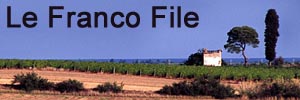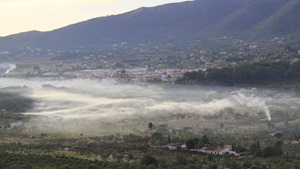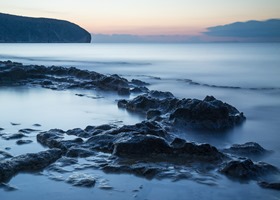In Another Victory for Automation [6th October, 2011], I reported on the problems caused by a particular black cloud of automation. The automation in question was the French “advance” of replacing warm bodies, many of whom actually smiled, at their autoroute toll booths with toll-taking machinery. The problem for the travelling public, a.k.a. paying customer, is that the machines are significantly slower than the humans they have replaced – I’d estimate 3-times slower on a good day. The result, of course, is that slow payment makes the queues [lines in Amerispeak] become longer at busy toll plazas [see, we Europeans are flexible enough to get the hang of Amerispeak] and therefore delays are noticeably longer. The benefit of such automation is entirely self-serving on the part of the autoroute [heck, we can even speak French] companies; it saves them money by enabling them to lay off many employees but the public is served less well.
Another very black cloud of automation has been looming on the horizon for a little while now but is now advancing alarmingly rapidly.
Today we arrived back in Spain – this trip is a week just so we can attend a meeting of the residence committee – at Alicante airport after a 2:45 AM alarm [:!:] to board a 6:15 AM easyJet flight from Luton airport. Unbeknownst to us, the black cloud had arrived at Alicante ahead of us.
We disembarked the plane at about 10:00 AM local time and began marching through the jet way and corridors towards immigration and baggage reclaim (not that we had any checked luggage).Everything looked normal, which is to say unhindered, until the final corridor. This last corridor was jammed with people. It was jammed with people six across and 50 or so deep. The people were largely not moving, the monotony of their lack of movement broken only occasionally by a small advance of a couple of inches. Ahead of us was a similar line of unmoving people approaching from the opposite direction. I eventually spotted that both lines were trying to get through a pair of sliding doors ahead – quite a way ahead – on my left. We’ve been flying in to Alicante for about eight years now and we’ never met any obstruction like this. Other than our route in, what on earth had changed?
Painfully slowly we finally got to the sliding doors, on the other side of which was a hall crammed with people. The crush of people was now a dozen wide and about 30 deep. Ahead of this human traffic jam, I spotted five or six poles with lights above, rather like the lights on a supermarket checkout till that is operating. I looked below the lights and the reason for this chaos became all too apparent. On several occasions we have wandered through immigration at Alicante with no immigration officers on duty checking passports. More recently, their have been warm bodies in booths checking passports and processing people rapidly such that almost no queue [line, in Amerispeak – come on guys, what’s so hard about the word queue?] would build up. Now here we were with the latest disastrous idea of computer modernization; each of the five or six lights was perched above an automatic passport reading machine. OH NO!
We’ve seen these passport machines and used them at Luton airport but at Luton airport there are still several warm bodies checking passports manually and, I might add one hell of a lot more quickly than these painfully pedestrian machines can check them. Besides, not everyone yet has the type of passport designed to be used by the infernal machines so it’s obvious that warm bodies are still necessary. This last is true even in Alicante. How many warm bodies did Alicante have checking passports manually? One, though I think she was there really to help Joe Bozo use the infernal machines. Eventually another man turned up to assist but he was getting rather ratty, shall we say, under the pressure of impatient visitors.
Even if Joe Bozo does everything right – stands on the correct spot, looks at the camera correctly with no obstructions, places his passport on the reading surface correctly, etc. – and uses the machine correctly first time, these blasted contraptions still take about two minutes to process one passport. One of the greatest delays is the bloody camera winding up and down to get to the right height for a 1.95m Dutchman after having just processed a 1.50m British female. The whole process is excruciatingly slow. And, of course, Joe Bozo does not generally get it right first time and the machine has to have a couple of bites at the cherry. Net result: these brilliant bloody machines cannot process people as fast as they are arriving on multiple 175-seat aircraft landing on a reasonably frequent basis. Hence Alicante’s new human log jam. Just imagine what the result would be if Boeing 747s were landing, each carrying 350 souls or, Darwin save us, Airbus 380s each with 450-500 aboard.
It’s my belief that an immigration officer, even a conscientious one, would process about 10 people in the time taken by one of these pathetic machines to process just one. [I exclude United States immigration officers who take their own sweet time to give everybody arriving the third degree before allowing them in and who have cheerlessly been causing huge lines (queues, for non-Amerispeakers) since Darwin showed God to be a fraud.] Whichever set of idiots ever thought these passport reading machines were a helpful solution really should be lined up against the wall and shot. That’d improve Darwin’s gene pool.
The current human tidal wave of economic migrants – I reject summarily the term refugees applied to people who are so picky about where they end up – into Europe has got the solution, of course: sod paperwork, bugger passports, just wander across any European border muttering “Germany” whilst looking disdainfully at us because we can’t cope with the impossibly high numbers in the flood. No infernal passport-reading machines on the beaches of the Greek islands, just discarded life jackets.

![]() Recovery Day was billed as being cloudy here – well, near here, anyway. We treated ourselves to some prawns and sat out on our naya basking in the sunshine that the clouds were bringing. Here’s my artist’s impression of our cloudy day, involving bare feet on terracotta tiles in a very pleasant 22C (shade temperature). I’ll take any amount of cloudy days such as this; they help recovery no end.
Recovery Day was billed as being cloudy here – well, near here, anyway. We treated ourselves to some prawns and sat out on our naya basking in the sunshine that the clouds were bringing. Here’s my artist’s impression of our cloudy day, involving bare feet on terracotta tiles in a very pleasant 22C (shade temperature). I’ll take any amount of cloudy days such as this; they help recovery no end.













Recent Comments